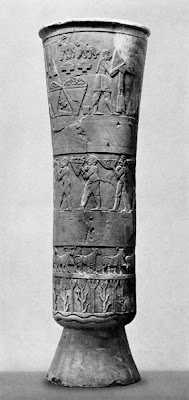Art and Civilization
The emergence of civilization is frequently defined or characterized in terms of an increase in the complexity of the structure and the functioning of human society by comparison to earlier phases. The development of the productive capacities of mankind may be said to be both, that is, dialectically, cause and consequence of changes affecting ways of life, social structure, material culture, technology, knowledge and ideology that separates primitive humanity from the early civilizations.
And yet we may observe that humanity advances by transforming the heritage of the past, it builds upon past accomplishments and in doing so transforms itself and transforms also the sense and meaning of its own past. In this sense, the past may be both support and obstacle to the development of human capacities and of social and cultural forms and processes. And in this sense also, the past lives on producing its effects either as active or as unconscious memory.
In the arts of the early civilizations, in Mesopotamia and Egypt, for instance, we will see the heritage of ancestral forms being more or less slowly transformed, developed and adapted to a new context, to fulfill new as well as analogous functions.
In the transition from Prehistoric Culture to Early Civilization we see the progressive establishment of the Arts as a specialized form of activity, the birth of an Art Industry, the development of a class of specialized art workers or craftsmen. The social division of work and the establishment of social class structure is the condition for the new cultural, social and political forms that will constitute the environment in which the Arts will flourish and develop.
An environment that the Arts will also contribute to create by providing the material consciousness, so to speak, that is, by supplying the concrete embodiment of the experiences, aspirations and ideas of the new times, serving to clarify, to fix or stabilize the forms in which are expressed the consciousness of the present, and by this helping to mold and establish the self-understanding of a new time.
And yet we may observe that humanity advances by transforming the heritage of the past, it builds upon past accomplishments and in doing so transforms itself and transforms also the sense and meaning of its own past. In this sense, the past may be both support and obstacle to the development of human capacities and of social and cultural forms and processes. And in this sense also, the past lives on producing its effects either as active or as unconscious memory.
In the arts of the early civilizations, in Mesopotamia and Egypt, for instance, we will see the heritage of ancestral forms being more or less slowly transformed, developed and adapted to a new context, to fulfill new as well as analogous functions.
In the transition from Prehistoric Culture to Early Civilization we see the progressive establishment of the Arts as a specialized form of activity, the birth of an Art Industry, the development of a class of specialized art workers or craftsmen. The social division of work and the establishment of social class structure is the condition for the new cultural, social and political forms that will constitute the environment in which the Arts will flourish and develop.
An environment that the Arts will also contribute to create by providing the material consciousness, so to speak, that is, by supplying the concrete embodiment of the experiences, aspirations and ideas of the new times, serving to clarify, to fix or stabilize the forms in which are expressed the consciousness of the present, and by this helping to mold and establish the self-understanding of a new time.
Marcelo Guimaraes Lima


Comments